Online Book Pop Art the Independent Group to Neo Pop
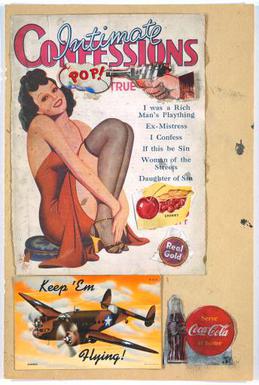
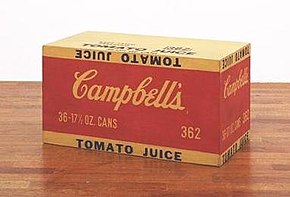
Pop art is an art move that emerged in the United Kingdom and the U.s.a. during the mid- to belatedly-1950s.[1] [2] The motility presented a claiming to traditions of art by including imagery from popular and mass culture, such as advertizing, comic books and mundane mass-produced objects. One of its aims is to use images of popular (equally opposed to elitist) culture in art, emphasizing the banal or kitschy elements of any culture, almost ofttimes through the use of irony.[3] It is also associated with the artists' use of mechanical ways of reproduction or rendering techniques. In pop art, material is sometimes visually removed from its known context, isolated, or combined with unrelated material.[2] [iii]
Amongst the early on artists that shaped the pop art movement were Eduardo Paolozzi and Richard Hamilton in U.k., and Larry Rivers, Ray Johnson. Robert Rauschenberg and Jasper Johns among others in the United States. Pop art is widely interpreted as a reaction to the then-dominant ideas of abstract expressionism, as well as an expansion of those ideas.[four] Due to its utilization of establish objects and images, it is similar to Dada. Pop art and minimalism are considered to exist art movements that precede postmodern art, or are some of the primeval examples of postmodern art themselves.[v]
Pop art oft takes imagery that is currently in use in advertising. Production labeling and logos figure prominently in the imagery chosen by pop artists, seen in the labels of Campbell'south Soup Cans, by Andy Warhol. Even the labeling on the outside of a aircraft box containing nutrient items for retail has been used every bit subject area matter in pop art, as demonstrated by Warhol'due south Campbell's Lycopersicon esculentum Juice Box, 1964 (pictured).
Origins [edit]
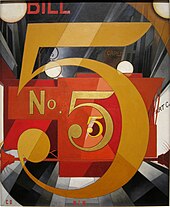
The origins of pop fine art in North America developed differently from Great United kingdom.[iii] In the U.s., pop fine art was a response by artists; it marked a return to hard-edged composition and representational fine art. They used impersonal, mundane reality, irony, and parody to "defuse" the personal symbolism and "painterly looseness" of abstruse expressionism.[4] [6] In the U.S., some artwork past Larry Rivers, Alex Katz and Man Ray anticipated pop art.[seven]
By contrast, the origins of pop art in postal service-War United kingdom, while employing irony and parody, were more than academic. Britain focused on the dynamic and paradoxical imagery of American popular culture as powerful, manipulative symbolic devices that were affecting whole patterns of life, while simultaneously improving the prosperity of a society.[6] Early pop art in Great britain was a matter of ideas fueled by American popular civilisation when viewed from afar.[4] Similarly, pop fine art was both an extension and a repudiation of Dadaism.[4] While pop art and Dadaism explored some of the aforementioned subjects, pop art replaced the subversive, satirical, and anarchic impulses of the Dada movement with a discrete affirmation of the artifacts of mass civilisation.[4] Amidst those artists in Europe seen as producing work leading up to popular art are: Pablo Picasso, Marcel Duchamp, and Kurt Schwitters.
Proto-pop [edit]
Although both British and American pop fine art began during the 1950s, Marcel Duchamp and others in Europe similar Francis Picabia and Man Ray predate the movement; in addition in that location were some earlier American proto-pop origins which utilized "as found" cultural objects.[four] During the 1920s, American artists Patrick Henry Bruce, Gerald Irish potato, Charles Demuth and Stuart Davis created paintings that contained pop civilization imagery (mundane objects culled from American commercial products and advertisement pattern), well-nigh "prefiguring" the popular art movement.[eight] [ix]
Great britain: the Independent Group [edit]
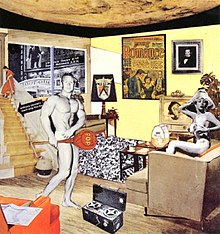
The Contained Grouping (IG), founded in London in 1952, is regarded as the precursor to the popular art movement.[2] [10] They were a gathering of immature painters, sculptors, architects, writers and critics who were challenging prevailing modernist approaches to civilisation as well every bit traditional views of fine art. Their group discussions centered on popular civilisation implications from elements such as mass advert, movies, product design, comic strips, scientific discipline fiction and applied science. At the starting time Independent Group meeting in 1952, co-founding member, artist and sculptor Eduardo Paolozzi presented a lecture using a series of collages titled Bunk! that he had assembled during his fourth dimension in Paris betwixt 1947 and 1949.[ii] [10] This material of "institute objects" such as advertising, comic book characters, magazine covers and various mass-produced graphics by and large represented American pop civilisation. Ane of the collages in that presentation was Paolozzi's I was a Rich Man'southward Plaything (1947), which includes the showtime employ of the discussion "popular", appearing in a cloud of smoke emerging from a revolver.[2] [11] Post-obit Paolozzi'due south seminal presentation in 1952, the IG focused primarily on the imagery of American popular civilisation, specially mass advert.[6]
According to the son of John McHale, the term "pop art" was first coined by his father in 1954 in conversation with Frank Cordell,[12] although other sources credit its origin to British critic Lawrence Alloway.[13] [xiv] (Both versions agree that the term was used in Independent Grouping discussions past mid-1955.)
"Pop art" every bit a moniker was and so used in discussions by IG members in the Second Session of the IG in 1955, and the specific term "popular fine art" first appeared in published print in the commodity "But Today We Collect Ads" by IG members Alison and Peter Smithson in Ark mag in 1956.[15] Even so, the term is frequently credited to British art critic/curator Lawrence Alloway for his 1958 essay titled The Arts and the Mass Media, even though the precise language he uses is "pop mass culture".[16] "Furthermore, what I meant by it so is not what information technology means now. I used the term, and also 'Pop Culture' to refer to the products of the mass media, not to works of art that draw upon popular culture. In any example, sometime between the winter of 1954–55 and 1957 the phrase acquired currency in conversation..."[17] Notwithstanding, Alloway was 1 of the leading critics to defend the inclusion of the imagery of mass culture in the fine arts. Alloway clarified these terms in 1966, at which fourth dimension Pop Art had already transited from art schools and small galleries to a major forcefulness in the artworld. But its success had not been in England. Practically simultaneously, and independently, New York City had become the hotbed for Pop Art.[17]
In London, the annual Majestic Order of British Artists (RBA) exhibition of immature talent in 1960 outset showed American popular influences. In January 1961, the most famous RBA-Immature Contemporaries of all put David Hockney, the American R B Kitaj, New Zealander Billy Apple, Allen Jones, Derek Boshier, Joe Tilson, Patrick Caulfield, Peter Phillips, Pauline Boty and Peter Blake on the map; Apple designed the posters and invitations for both the 1961 and 1962 Young Contemporaries exhibitions.[18] Hockney, Kitaj and Blake went on to win prizes at the John-Moores-Exhibition in Liverpool in the aforementioned year. Apple and Hockney traveled together to New York during the Royal College's 1961 summer break, which is when Apple first fabricated contact with Andy Warhol – both later moved to the United States and Apple tree became involved with the New York pop art scene.[18]
U.s. [edit]
Although popular art began in the early 1950s, in America it was given its greatest impetus during the 1960s. The term "pop art" was officially introduced in Dec 1962; the occasion was a "Symposium on Pop Art" organized by the Museum of Modern Art.[xix] By this time, American advertising had adopted many elements of modern art and functioned at a very sophisticated level. Consequently, American artists had to search deeper for dramatic styles that would distance art from the well-designed and clever commercial materials.[six] As the British viewed American popular culture imagery from a somewhat removed perspective, their views were oft instilled with romantic, sentimental and humorous overtones. By dissimilarity, American artists, bombarded every day with the multifariousness of mass-produced imagery, produced piece of work that was generally more assuming and aggressive.[10]

Co-ordinate to historian, curator and critic Henry Geldzahler, "Ray Johnson'south collages Elvis Presley No. 1 and James Dean stand equally the Plymouth Stone of the Pop movement."[xx] Writer Lucy Lippard wrote that "The Elvis ... and Marilyn Monroe [collages] ... heralded Warholian Pop."[21] Johnson worked as a graphic designer, met Andy Warhol past 1956 and both designed several book covers for New Directions and other publishers. Johnson began mailing out whimsical flyers advertizement his design services printed via kickoff lithography. He later became known as the father of mail art as the founder of his "New York Correspondence School," working small past stuffing clippings and drawings into envelopes rather than working larger like his contemporaries.[22] A note about the encompass image in January 1958's Art News pointed out that "[Jasper] Johns' first one-human show ... places him with such better-known colleagues equally Rauschenberg, Twombly, Kaprow and Ray Johnson".[23]
Indeed, ii other important artists in the establishment of America's pop art vocabulary were the painters Jasper Johns and Robert Rauschenberg.[x] Rauschenberg, who like Ray Johnson attended Black Mountain Higher in Due north Carolina after World War II, was influenced past the earlier piece of work of Kurt Schwitters and other Dada artists, and his belief that "painting relates to both art and life" challenged the dominant modernist perspective of his time.[24] His use of discarded readymade objects (in his Combines) and pop culture imagery (in his silkscreen paintings) connected his works to topical events in everyday America.[x] [25] [26] The silkscreen paintings of 1962–64 combined expressive brushwork with silkscreened magazine clippings from Life, Newsweek, and National Geographic. Johns' paintings of flags, targets, numbers, and maps of the U.S. as well three-dimensional depictions of ale cans drew attending to questions of representation in art.[27] Johns' and Rauschenberg's work of the 1950s is frequently referred to as Neo-Dada, and is visually distinct from the prototypical American pop art which exploded in the early 1960s.[28] [29]
Roy Lichtenstein is of equal importance to American pop art. His piece of work, and its utilize of parody, probably defines the basic premise of pop art better than any other.[10] Selecting the old-fashioned comic strip every bit subject area matter, Lichtenstein produces a difficult-edged, precise composition that documents while likewise parodying in a soft manner. Lichtenstein used oil and Magna paint in his best known works, such as Drowning Girl (1963), which was appropriated from the atomic number 82 story in DC Comics' Hole-and-corner Hearts #83. (Drowning Daughter is part of the collection of the Museum of Modern Fine art.)[30] His work features thick outlines, bold colors and Ben-Day dots to correspond certain colors, as if created by photographic reproduction. Lichtenstein said, "[abstract expressionists] put things downward on the canvas and responded to what they had done, to the color positions and sizes. My style looks completely dissimilar, but the nature of putting downwards lines pretty much is the same; mine just don't come up out looking calligraphic, like Pollock's or Kline's."[31] Pop fine art merges popular and mass civilization with fine art while injecting humor, irony, and recognizable imagery/content into the mix.
The paintings of Lichtenstein, like those of Andy Warhol, Tom Wesselmann and others, share a direct zipper to the commonplace image of American popular civilization, simply besides treat the discipline in an impersonal fashion clearly illustrating the idealization of mass product.[x]
Andy Warhol is probably the well-nigh famous figure in pop art. In fact, art critic Arthur Danto one time called Warhol "the nearest affair to a philosophical genius the history of art has produced".[19] Warhol attempted to take pop beyond an artistic style to a life style, and his work often displays a lack of homo affectation that dispenses with the irony and parody of many of his peers.[32] [33]
Early on U.S. exhibitions [edit]
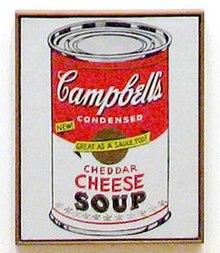
The Cheddar Cheese sail from Andy Warhol's Campbell'south Soup Cans, 1962.
Claes Oldenburg, Jim Dine and Tom Wesselmann had their first shows in the Judson Gallery in 1959 and 1960 and later in 1960 through 1964 along with James Rosenquist, George Segal and others at the Dark-green Gallery on 57th Street in Manhattan. In 1960, Martha Jackson showed installations and assemblages, New Media – New Forms featured Hans Arp, Kurt Schwitters, Jasper Johns, Claes Oldenburg, Robert Rauschenberg, Jim Dine and May Wilson. 1961 was the year of Martha Jackson's spring show, Environments, Situations, Spaces.[34] [35] Andy Warhol held his first solo exhibition in Los Angeles in July 1962 at Irving Blum's Ferus Gallery, where he showed 32 paintings of Campell'southward soup cans, one for every flavor. Warhol sold the prepare of paintings to Blum for $1,000; in 1996, when the Museum of Modern Art acquired it, the set was valued at $fifteen million.[xix]
Donald Factor, the son of Max Factor Jr., and an art collector and co-editor of advanced literary magazine Nomad, wrote an essay in the magazine's final issue, Nomad/New York. The essay was one of the offset on what would become known as popular fine art, though Factor did not use the term. The essay, "Four Artists", focused on Roy Lichtenstein, James Rosenquist, Jim Dine, and Claes Oldenburg.[36]
In the 1960s, Oldenburg, who became associated with the pop fine art motion, created many happenings, which were performance fine art-related productions of that time. The name he gave to his own productions was "Ray Gun Theater". The cast of colleagues in his performances included: artists Lucas Samaras, Tom Wesselmann, Carolee Schneemann, Öyvind Fahlström and Richard Artschwager; dealer Annina Nosei; art critic Barbara Rose; and screenwriter Rudy Wurlitzer.[37] His first wife, Patty Mucha, who sewed many of his early on soft sculptures, was a constant performer in his happenings. This brash, often humorous, approach to art was at great odds with the prevailing sensibility that, by its nature, art dealt with "profound" expressions or ideas. In December 1961, he rented a store on Manhattan's Lower East Side to house The Shop, a month-long installation he had first presented at the Martha Jackson Gallery in New York, stocked with sculptures roughly in the form of consumer goods.[37]
Opening in 1962, Willem de Kooning's New York fine art dealer, the Sidney Janis Gallery, organized the groundbreaking International Exhibition of the New Realists, a survey of new-to-the-scene American, French, Swiss, Italian New Realism, and British pop art. The fifty-iv artists shown included Richard Lindner, Wayne Thiebaud, Roy Lichtenstein (and his painting Blam), Andy Warhol, Claes Oldenburg, James Rosenquist, Jim Dine, Robert Indiana, Tom Wesselmann, George Segal, Peter Phillips, Peter Blake (The Honey Wall from 1961), Öyvind Fahlström, Yves Klein, Arman, Daniel Spoerri, Christo and Mimmo Rotella. The show was seen past Europeans Martial Raysse, Niki de Saint Phalle and Jean Tinguely in New York, who were stunned past the size and expect of the American artwork. Also shown were Marisol, Mario Schifano, Enrico Baj and Öyvind Fahlström. Janis lost some of his abstruse expressionist artists when Marking Rothko, Robert Motherwell, Adolph Gottlieb and Philip Guston quit the gallery, but gained Dine, Oldenburg, Segal and Wesselmann.[38] At an opening-night soiree thrown by collector Burton Tremaine, Willem de Kooning appeared and was turned abroad by Tremaine, who ironically endemic a number of de Kooning's works. Rosenquist recalled: "at that moment I thought, something in the art world has definitely changed".[19] Turning away a respected abstract artist proved that, equally early as 1962, the pop art movement had begun to dominate art culture in New York.
A bit earlier, on the West Declension, Roy Lichtenstein, Jim Dine and Andy Warhol from New York Urban center; Phillip Hefferton and Robert Dowd from Detroit; Edward Ruscha and Joe Goode from Oklahoma City; and Wayne Thiebaud from California were included in the New Painting of Mutual Objects evidence. This first popular art museum exhibition in America was curated by Walter Hopps at the Pasadena Art Museum.[39] Popular art was set to change the art world. New York followed Pasadena in 1963, when the Guggenheim Museum exhibited Six Painters and the Object, curated by Lawrence Alloway. The artists were Jim Dine, Jasper Johns, Roy Lichtenstein, Robert Rauschenberg, James Rosenquist, and Andy Warhol.[40] Another pivotal early exhibition was The American Supermarket organised by the Bianchini Gallery in 1964. The show was presented as a typical pocket-sized supermarket environment, except that everything in it—the produce, canned goods, meat, posters on the wall, etc.—was created past prominent pop artists of the time, including Apple, Warhol, Lichtenstein, Wesselmann, Oldenburg, and Johns. This project was recreated in 2002 equally office of the Tate Gallery'south Shopping: A Century of Art and Consumer Culture.[41]
By 1962, pop artists started exhibiting in commercial galleries in New York and Los Angeles; for some, it was their start commercial one-man show. The Ferus Gallery presented Andy Warhol in Los Angeles (and Ed Ruscha in 1963). In New York, the Green Gallery showed Rosenquist, Segal, Oldenburg, and Wesselmann. The Stable Gallery showed R. Indiana and Warhol (in his first New York bear witness). The Leo Castelli Gallery presented Rauschenberg, Johns, and Lichtenstein. Martha Jackson showed Jim Dine and Allen Stone showed Wayne Thiebaud. By 1966, after the Green Gallery and the Ferus Gallery airtight, the Leo Castelli Gallery represented Rosenquist, Warhol, Rauschenberg, Johns, Lichtenstein and Ruscha. The Sidney Janis Gallery represented Oldenburg, Segal, Dine, Wesselmann and Marisol, while Allen Stone continued to represent Thiebaud, and Martha Jackson connected representing Robert Indiana.[42]
In 1968, the São Paulo 9 Exhibition – Surround The statesA.: 1957–1967 featured the "Who'south Who" of pop fine art. Considered equally a summation of the classical phase of the American pop art flow, the exhibit was curated past William Seitz. The artists were Edward Hopper, James Gill, Robert Indiana, Jasper Johns, Roy Lichtenstein, Claes Oldenburg, Robert Rauschenberg, Andy Warhol and Tom Wesselmann.[43]
France [edit]
Nouveau réalisme refers to an artistic movement founded in 1960 by the art critic Pierre Restany[44] and the artist Yves Klein during the first collective exposition in the Apollinaire gallery in Milan. Pierre Restany wrote the original manifesto for the group, titled the "Constitutive Declaration of New Realism," in Apr 1960, proclaiming, "Nouveau Réalisme—new ways of perceiving the real."[45] This joint announcement was signed on 27 Oct 1960, in Yves Klein's workshop, past nine people: Yves Klein, Arman, Martial Raysse, Pierre Restany, Daniel Spoerri, Jean Tinguely and the Ultra-Lettrists, Francois Dufrêne, Raymond Hains, Jacques de la Villeglé; in 1961 these were joined by César, Mimmo Rotella, then Niki de Saint Phalle and Gérard Deschamps. The artist Christo showed with the group. It was dissolved in 1970.[45]
Contemporary of American Pop Art—often conceived as its transposition in France—new realism was along with Fluxus and other groups one of the numerous tendencies of the avant-garde in the 1960s. The group initially chose Nice, on the French Riviera, as its abode base of operations since Klein and Arman both originated there; new realism is thus ofttimes retrospectively considered past historians to be an early representative of the École de Nice motion.[46] In spite of the diversity of their plastic linguistic communication, they perceived a mutual footing for their work; this being a method of direct appropriation of reality, equivalent, in the terms used by Restany; to a "poetic recycling of urban, industrial and ad reality".[47]
Kingdom of spain [edit]
In Espana, the study of pop art is associated with the "new figurative", which arose from the roots of the crunch of informalism. Eduardo Arroyo could be said to fit within the pop art trend, on account of his interest in the surroundings, his critique of our media culture which incorporates icons of both mass media advice and the history of painting, and his scorn for most all established artistic styles. However, the Spanish creative person who could be considered most authentically part of "pop" art is Alfredo Alcaín, because of the use he makes of pop images and empty spaces in his compositions.
Also in the category of Spanish pop art is the "Relate Team" (El Equipo Crónica), which existed in Valencia between 1964 and 1981, formed past the artists Manolo Valdés and Rafael Solbes. Their movement can be characterized as "popular" because of its employ of comics and publicity images and its simplification of images and photographic compositions. Filmmaker Pedro Almodóvar emerged from Madrid'south "La Movida" subculture of the 1970s making depression budget super 8 popular art movies, and he was subsequently chosen the Andy Warhol of Spain by the media at the fourth dimension. In the book Almodovar on Almodovar, he is quoted as proverb that the 1950s film "Funny Face" was a central inspiration for his piece of work. Ane pop trademark in Almodovar's films is that he always produces a fake commercial to exist inserted into a scene.
New Zealand [edit]
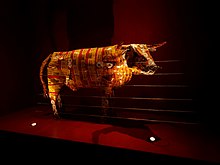
In New Zealand, pop art has predominately flourished since the 1990s, and is oftentimes connected to Kiwiana. Kiwiana is a popular-centered, idealised representation of classically Kiwi icons, such as meat pies, kiwifruit, tractors, jandals, Four Foursquare supermarkets; the inherent campness of this is ofttimes subverted to signify cultural messages.[48] Dick Frizzell is a famous New Zealand pop artist, known for using older Kiwiana symbols in means that parody modern culture. For example, Frizzell enjoys imitating the work of foreign artists, giving their works a unique New Zealand view or influence. This is done to show New Zealand'southward historically subdued bear upon on the world; naive fine art is continued to Aotearoan popular art this mode.[49]
This can exist also done in an annoying and deadpan fashion, every bit with Michel Tuffrey's famous work Pisupo Lua Afe (Corned Beef 2000). Of Samoan ancestry, Tuffery constructed the work, which represents a balderdash, out of processed food cans known every bit pisupo. It is a unique work of western popular art considering Tuffrey includes themes of neocolonialism and racism against non-western cultures (signified by the food cans the work is made of, which represent economic dependence brought on Samoans by the west). The undeniable indigenous viewpoint makes it stand out against more mutual non-indigenous works of popular art.[50] [51]
One of New Zealand's earliest and famous pop artists is Billy Apple, ane of the few non-British members of the Royal Gild of British Artists. Featured among the likes of David Hockney, American R.B. Kitaj and Peter Blake in the January 1961 RBA exhibition Immature Contemporaries, Apple quickly became an iconic international creative person of the 1960s. This was earlier he conceived his moniker of 'Billy Apple", and his work was displayed under his birth name of Barrie Bates. He sought to distinguish himself by appearance as well equally name, then bleached his pilus and eyebrows with Lady Clairol Instant Creme Whip. Later, Apple was associated with the 1970s Conceptual Fine art movement. [52]
Japan [edit]
In Japan, popular fine art evolved from the nation'due south prominent avant-garde scene. The apply of images of the modern world, copied from magazines in the photomontage-mode paintings produced by Harue Koga in the late 1920s and early 1930s, foreshadowed elements of pop art.[53] The Japanese Gutai move led to a 1958 Gutai exhibition at Martha Jackson's New York gallery that preceded by 2 years her famous New Forms New Media show that put Pop Art on the map.[54] The piece of work of Yayoi Kusama contributed to the development of pop fine art and influenced many other artists, including Andy Warhol.[55] [56] In the mid-1960s, graphic designer Tadanori Yokoo became i of the most successful pop artists and an international symbol for Japanese pop art. He is well known for his advertisements and creating artwork for popular culture icons such equally commissions from The Beatles, Marilyn Monroe, and Elizabeth Taylor, among others.[57] Another leading popular artist at that fourth dimension was Keiichi Tanaami. Iconic characters from Japanese manga and anime have also become symbols for pop fine art, such equally Speed Racer and Astro Boy. Japanese manga and anime also influenced later pop artists such every bit Takashi Murakami and his superflat movement.
Italy [edit]
In Italian republic, by 1964, pop art was known and took different forms, such equally the "Scuola di Piazza del Popolo" in Rome, with pop artists such as Mario Schifano, Franco Angeli, Giosetta Fioroni, Tano Festa, Claudio Cintoli, and some artworks by Piero Manzoni, Lucio Del Pezzo, Mimmo Rotella and Valerio Adami.
Italian pop fine art originated in 1950s culture – the works of the artists Enrico Baj and Mimmo Rotella to be precise, rightly considered the forerunners of this scene. In fact, it was around 1958–1959 that Baj and Rotella abandoned their previous careers (which might be generically defined equally belonging to a non-representational genre, despite being thoroughly post-Dadaist), to catapult themselves into a new earth of images, and the reflections on them, which was springing upward all around them. Rotella's torn posters showed an ever more figurative taste, ofttimes explicitly and deliberately referring to the great icons of the times. Baj'southward compositions were steeped in contemporary kitsch, which turned out to be a "gilt mine" of images and the stimulus for an entire generation of artists.
The novelty came from the new visual panorama, both inside "domestic walls" and out-of-doors. Cars, road signs, television, all the "new world", everything can vest to the world of art, which itself is new. In this respect, Italian pop art takes the same ideological path as that of the international scene. The only matter that changes is the iconography and, in some cases, the presence of a more critical attitude toward it. Even in this example, the prototypes tin be traced back to the works of Rotella and Baj, both far from neutral in their relationship with society. Yet this is not an exclusive element; there is a long line of artists, including Gianni Ruffi, Roberto Barni, Silvio Pasotti, Umberto Bignardi, and Claudio Cintoli, who take on reality every bit a toy, as a great pool of imagery from which to describe textile with disenchantment and frivolity, questioning the traditional linguistic office models with a renewed spirit of "allow me have fun" à la Aldo Palazzeschi.[58]

Belgium [edit]
In Belgium, pop art was represented to some extent by Paul Van Hoeydonck, whose sculpture Fallen Astronaut was left on the Moon during ane of the Apollo missions, too every bit by other notable pop artists. Internationally recognized artists such as Marcel Broodthaers ( 'vous êtes doll? "), Evelyne Axell and Panamarenko are indebted to the pop fine art movement; Broodthaers'due south nifty influence was George Segal. Another well-known artist, Roger Raveel, mounted a birdcage with a existent live dove in one of his paintings. By the end of the 1960s and early 1970s, pop art references disappeared from the work of some of these artists when they started to prefer a more than critical attitude towards America considering of the Vietnam War's increasingly gruesome graphic symbol. Panamarenko, however, has retained the irony inherent in the pop art movement upwards to the present day. Evelyne Axell from Namur was a prolific popular-artist in the 1964–1972 period. Axell was 1 of the first female popular artists, had been mentored by Magritte and her best-known painting is Ice Foam.[59]
Netherlands [edit]
While there was no formal pop art motion in the Netherlands, there were a group of artists that spent time in New York during the early years of pop art, and drew inspiration from the international pop art motion. Representatives of Dutch pop art include Daan van Gilt, Gustave Asselbergs, Jacques Frenken, Jan Cremer, Wim T. Schippers, and Woody van Amen. They opposed the Dutch petit conservative mentality by creating humorous works with a serious undertone. Examples of this nature include Sex O'Clock, by Woody van Amen, and Crucifix / Target, by Jacques Frenken.[60]
Russian federation [edit]
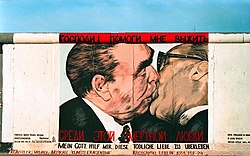
Russia was a picayune tardily to become part of the pop art motility, and some of the artwork that resembles pop art but surfaced around the early on 1970s, when Russia was a communist country and bold artistic statements were closely monitored. Russia'southward own version of pop art was Soviet-themed and was referred to as Sots Art. After 1991, the Communist Political party lost its ability, and with it came a freedom to express. Pop art in Russia took on another form, epitomised by Dmitri Vrubel with his painting titled My God, Help Me to Survive This Mortiferous Dearest in 1990. It might be argued that the Soviet posters made in the 1950s to promote the wealth of the nation were in itself a course of pop art.[61]
Notable artists [edit]
- Baton Apple (1935-2021)
- Evelyne Axell (1935–1972)
- Sir Peter Blake (born 1932)
- Derek Boshier (born 1937)
- Pauline Boty (1938–1966)
- Patrick Caulfield (1936–2005)
- Allan D'Arcangelo (1930–1998)
- Jim Dine (built-in 1935)
- Burhan Dogancay (1929–2013)
- Rosalyn Drexler (born 1926)
- Robert Dowd (1936–1996)
- Ken Elias (born 1944)
- Erró (built-in 1932)
- Marisol Escobar (1930–2016)
- James Gill (born 1934)
- Dorothy Grebenak (1913-1990)
- Red Grooms (built-in 1937)
- Richard Hamilton (1922–2011)
- Keith Haring (1958–1990)
- Jann Haworth (born 1942)
- David Hockney (built-in 1937)
- Dorothy Iannone (built-in 1933)
- Robert Indiana (1928–2018)
- Jasper Johns (built-in 1930)
- Ray Johnson (1927-1995)
- Allen Jones (born 1937)
- Alex Katz (born 1927)
- Corita Kent (1918–1986)
- Konrad Klapheck (built-in 1935)
- Kiki Kogelnik (1935–1997)
- Nicholas Krushenick (1929–1999)
- Yayoi Kusama (born 1929)
- Gerald Laing (1936–2011)
- Roy Lichtenstein (1923–1997)
- Richard Lindner (1901–1978)
- John McHale (1922–1978)
- Peter Max (born 1937)
- Marta Minujin (born 1943)
- Claes Oldenburg (born 1929)
- Julian Opie (built-in 1958)
- Eduardo Paolozzi (1924–2005)
- Peter Phillips (built-in 1939)
- Sigmar Polke (1941–2010)
- Hariton Pushwagner (1940–2018)
- Mel Ramos (1935–2018)
- Robert Rauschenberg (1925–2008)
- Larry Rivers (1923–2002)
- James Rizzi (1950–2011)
- James Rosenquist (1933–2017)
- Niki de Saint Phalle (1930–2002)
- Peter Saul (built-in 1934)
- George Segal (1924–2000)
- Colin Self (born 1941)
- Marjorie Strider (1931–2014)
- Elaine Sturtevant (1924-2014)
- Wayne Thiebaud (born 1920)
- Joe Tilson (born 1928)
- Andy Warhol (1928–1987)
- Idelle Weber (1932–2020)
- John Wesley (born 1928)
- Tom Wesselmann (1931–2004)
Run across likewise [edit]
- Art pop
- Chicago Imagists
- Ferus Gallery
- Sidney Janis
- Leo Castelli
- Green Gallery
- New Painting of Common Objects
- Figuration Libre (art movement)
- Lowbrow (art move)
- Nouveau réalisme
- Neo-pop
- Op art
- Plop art
- Retro art
- Superflat
- SoFlo Superflat
References [edit]
- ^ Pop Art: A Brief History, MoMA Learning
- ^ a b c d eastward Livingstone, M., Pop Art: A Continuing History, New York: Harry N. Abrams, Inc., 1990
- ^ a b c de la Croix, H.; Tansey, R., Gardner's Art Through the Ages, New York: Harcourt Caryatid Jovanovich, Inc., 1980.
- ^ a b c d e f Piper, David. The Illustrated History of Art, ISBN 0-7537-0179-0, p486-487.
- ^ Harrison, Sylvia (2001-08-27). Pop Art and the Origins of Mail service-Modernism. Cambridge University Press.
- ^ a b c d Gopnik, A.; Varnedoe, Thousand., High & Depression: Modernistic Art & Popular Civilisation, New York: The Museum of Modern Art, 1990
- ^ "History, Travel, Arts, Science, People, Places | Smithsonian". Smithsonianmag.com . Retrieved 2015-12-30 .
- ^ "Mod Love". The New Yorker. 2007-08-06. Retrieved 2015-12-30 .
- ^ Wayne Craven, American Fine art: History and . p.464.
- ^ a b c d e f g Arnason, H., History of Modernistic Art: Painting, Sculpture, Architecture, New York: Harry Northward. Abrams, Inc. 1968.
- ^ "'I was a Rich Man's Plaything', Sir Eduardo Paolozzi". Tate. 2015-12-10. Retrieved 2015-12-thirty .
- ^ "John McHale". Warholstars.org . Retrieved 2015-12-xxx .
- ^ "Pop fine art", A Dictionary of Twentieth-Century Art, Ian Chilvers. Oxford University Press, 1998.
- ^ "Pop art", The Concise Oxford Dictionary of Fine art Terms, Michael Clarke, Oxford University Press, 2001.
- ^ Alison and Peter Smithson, "But Today We Collect Ads", reprinted on page 54 in Modern Dreams The Rise and Fall of Pop, published past ICA and MIT, ISBN 0-262-73081-two
- ^ Lawrence Alloway, "The Arts and the Mass Media," Architectural Blueprint & Construction, Feb 1958.
- ^ a b Klaus Honnef, Pop Art, Taschen, 2004, p. vi, ISBN 3822822183
- ^ a b Barton, Christina (2010). Billy Apple: British and American Works 1960–69. London: The Mayor Gallery. pp. 11–21. ISBN978-0-9558367-3-2.
- ^ a b c d Scherman, Tony. "When Pop Turned the Art Globe Upside Down." American Heritage 52.1 (February 2001), 68.
- ^ Geldzahler, Henry in Popular Fine art: 1955–1970 catalogue, Fine art Gallery of New Due south Wales, Sydney, 1985
- ^ Lippard, Lucy in Ray Johnson: Correspondences catalogue, Wexner Heart/Whitney Museum, 2000
- ^ Bloch, Marking. "An Illustrated Introduction to Ray Johnson 1927-1995", 1995
- ^ Author unknown. "(Tabular array of contents, Untitled notation near cover.)", Art News, vol. 56, no. nine, January 1958
- ^ Rauschenberg, Robert; Miller, Dorothy C. (1959). Sixteen Americans [exhibition]. New York: Museum of Modern Art. p. 58. ISBN 978-0029156704. OCLC 748990996. "Painting relates to both fine art and life. Neither can be made. (I try to act in that gap between the 2.)"
- ^ "Fine art: Pop Art – Cult of the Commonplace". Time. 1963-05-03. ISSN 0040-781X. Retrieved 2020-07-07 .
Robert Rauschenberg, 37, remembers an fine art teacher who 'taught me to recall, "Why non?"' Since Rauschenberg is considered to be a pioneer in pop art, this is probably where the motion went off on its particular tangent. Why non make art out of old newspapers, bits of wearable, Coke bottles, books, skates, clocks?
- ^ Sandler, Irving H. The New York School: The Painters and Sculptors of the Fifties, New York: Harper & Row, 1978. ISBN 0-06-438505-1 pp. 174–195, Rauschenberg and Johns; pp. 103–111, Rivers and the gestural realists.
- ^ Rosenthal, Nan (October 2004). "Jasper Johns (born 1930) In Heilbrunn Timeline of Fine art History". The Metropolitan Museum of Art . Retrieved May ii, 2021.
- ^ Robert Rosenblum, "Jasper Johns" Art International (September 1960): 75.
- ^ Hapgood, Susan, Neo-Dada: Redefining Fine art, 1958–62. New York: Universe Books, 1994.
- ^ Hendrickson, Janis (1988). Roy Lichtenstein. Cologne, Deutschland: Benedikt Taschen. p. 31. ISBNiii-8228-0281-6.
- ^ Kimmelman, Michael (September thirty, 1997). "Roy Lichtenstein, Pop Principal, Dies at 73". New York Times . Retrieved November 12, 2007.
- ^ Michelson, Annette, Buchloh, B. H. D. (eds) Andy Warhol (October Files), MIT Press, 2001.
- ^ Warhol, Andy. The Philosophy of Andy Warhol, from A to B and dorsum over again. Harcourt Brace Jovanovich, 1975
- ^ "The Collection". MoMA.org . Retrieved 2015-12-30 .
- ^ "The Neat American Popular Art Store: Multiples of the Sixties". Tfaoi.com . Retrieved 2015-12-30 .
- ^ Diggory (2013).
- ^ a b Kristine McKenna (July 2, 1995), When Bigger Is Better: Claes Oldenburg has spent the past 35 years blowing up and redefining everyday objects, all in the proper name of getting art off its pedestal Los Angeles Times.
- ^ Reva Wolf (1997-11-24). Andy Warhol, Poetry, and Gossip in the 1960s. p. 83. ISBN9780226904931 . Retrieved 2015-12-30 .
- ^ "Museum History » Norton Simon Museum". Nortonsimon.org . Retrieved 2015-12-30 .
- ^ Six painters and the object. Lawrence Alloway [curator, conceived and prepared this exhibition and the catalogue] (Computer file). 2009-07-24. OCLC 360205683.
- ^ Gayford, Martin (2002-12-19). "Nonetheless life at the check-out". The Telegraph. Telegraph Media Group Ltd. Archived from the original on 2022-01-11. Retrieved 28 November 2012.
- ^ Popular Artists: Andy Warhol, Popular Art, Roy Lichtenstein, Jasper Johns, Peter Max, Erró, David Hockney, Wally Hedrick, Michael Leavitt (May 20, 2010) Reprinted: 2010, General Books, Memphis, Tennessee, USA, ISBN 978-i-155-48349-8, ISBN 1-155-48349-9.
- ^ Jim Edwards, William Emboden, David McCarthy: Uncommonplaces: The Art of James Francis Gill, 2005, p.54
- ^ Karl Ruhrberg, Ingo F. Walther, Art of the 20th Century, Taschen, 2000, p. 518. ISBN 3-8228-5907-9
- ^ a b Kerstin Stremmel, Realism, Taschen, 2004, p. xiii. ISBN 3-8228-2942-0
- ^ Rosemary M. O'Neill, Art and Visual Civilization on the French Riviera, 1956–1971: The Ecole de Nice, Ashgate, 2012, p. 93.
- ^ sixty/90. Trente ans de Nouveau Réalisme, La Différence, 1990, p. 76
- ^ "Op + Pop". christchurchartgallery.org.nz . Retrieved 2021-07-22 .
- ^ "Dick Frizzell - Overview". The Central . Retrieved 2021-07-22 .
- ^ "Loading... | Collections Online - Museum of New Zealand Te Papa Tongarewa". collections.tepapa.govt.nz . Retrieved 2021-07-22 .
- ^ "Loading... | Collections Online - Museum of New Zealand Te Papa Tongarewa". collections.tepapa.govt.nz . Retrieved 2021-07-22 .
- ^ "ARTSPACE - Baton Apple". 2013-02-09. Archived from the original on 2013-02-09. Retrieved 2021-07-29 .
- ^ Eskola, Jack (2015). Harue Koga: David Bowie of the Early 20th Century Japanese Art Advanced. Kindle, east-book.
- ^ Bloch, Mark. The Brooklyn Runway. "Gutai: 1953 –1959", June 2018.
- ^ "Yayoi Kusama interview – Yayoi Kusama exhibition". Timeout.com. 2013-01-30. Retrieved 2015-12-thirty .
- ^ [1] Archived Nov 1, 2012, at the Wayback Machine
- ^ "Tadanori Yokoo : ADC • Global Awards & Club". Adcglobal.org. 1936-06-27. Retrieved 2015-12-thirty .
- ^ "Pop Art Italia 1958–1968 — Galleria Civica". Comune.modena.information technology . Retrieved 2015-12-30 .
- ^ "Philadelphia Museum of Fine art Wins Fight with Facebook over Racy Pop Art Painting". artnet.com. 11 February 2016. Retrieved 2020-01-17 .
- ^ "Dutch Pop Art & The Sixties – Weg met de vertrutting!". 8weekly.nl. 28 July 2005. Retrieved 2015-12-30 .
- ^ [2] Archived June vii, 2013, at the Wayback Motorcar
Farther reading [edit]
- Bloch, Mark. The Brooklyn Rail. "Gutai: 1953 –1959", June 2018.
- Diggory, Terence (2013) Encyclopedia of the New York School Poets (Facts on File Library of American Literature). ISBN 978-ane-4381-4066-7
- Francis, Mark and Foster, Hal (2010) Pop. London and New York: Phaidon.
- Haskell, Barbara (1984) BLAM! The Explosion of Pop, Minimalism and Functioning 1958–1964. New York: W.Due west. Norton & Company, Inc. in association with the Whitney Museum of American Fine art.
- Lifshitz, Mikhail, The Crisis of Ugliness: From Cubism to Pop-Art. Translated and with an Introduction by David Riff. Leiden: BRILL, 2018 (originally published in Russian by Iskusstvo, 1968).
- Lippard, Lucy R. (1966) Pop Art, with contributions by Lawrence Alloway, Nancy Marmer, Nicolas Calas, Frederick A. Praeger, New York.
- Selz, Peter (moderator); Ashton, Dore; Geldzahler, Henry; Kramer, Hilton; Kunitz, Stanley and Steinberg, Leo (April 1963) "A symposium on Popular Art" Arts Magazine, pp. 36–45. Transcript of symposium held at the Museum of Mod Art on Dec 13, 1962.
External links [edit]
| | Wikimedia Commons has media related to Pop art. |
| | Wikiquote has quotations related to: Popular art |
- Popular Fine art: A Brief History, MoMA Learning
- Pop Fine art in Modernistic and Contemporary Fine art, The Met
- Brooklyn Museum Exhibitions: Seductive Subversion: Women Pop Artists, 1958–1968, Oct. 2010-Jan. 2011
- Brooklyn Museum, Wiki/Pop (Women Popular Artists)
- Tate Glossary term for Pop art
Source: https://en.wikipedia.org/wiki/Pop_art
0 Response to "Online Book Pop Art the Independent Group to Neo Pop"
Post a Comment